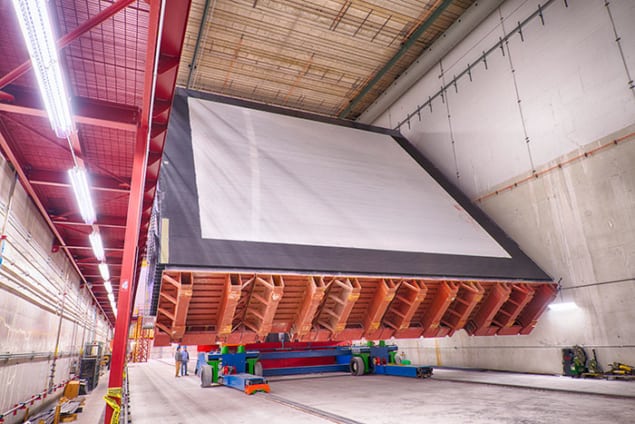
Construction of a giant neutrino experiment operated by the Fermi National Accelerator Laboratory (Fermilab) in the US was completed on schedule last month and under budget. The NOvA experiment is made up of two colossal detectors – one at Fermilab near Chicago and the other 800 km away deep in the North Woods, Minnesota. NOvA is the most powerful accelerator-based neutrino experiment to be built in the US and the one with the furthest diatance between detectors in the world.
“Neutrino research is one of the cornerstones of Fermilab’s future and an important part of the worldwide particle-physics programme,” says Fermilab director Nigel Lockyer. “We’re proud of the NOvA team for completing the construction of this world-class experiment, and we’re looking forward to seeing the first results in 2015.” Although the first plans for NOvA were approved by the US Department of Energy in 2007, budget cutbacks meant that its construction only began in 2009.
Ghostly particles
Interacting with matter only via the weak force and being so fiendishly difficult to detect, neutrinos come in three different types or “flavours” – electron, muon and tau – and change or “oscillate” from one type to another as they travel over long distances. NOvAs two detectors sit in the path of an extremely powerful beam of neutrinos that will be sent from Fermilab. The 300-tonne “near detector” is installed underground at Fermilab and aims to observe the neutrinos as they set off. The 14,000-tonne “far detector” – constructed in Ash River near the Canadian border – will spot them after their 800 km trip, which the neutrinos will make in less than three milliseconds.
Beaming out
The far detector in Minnesota is thought to be the largest free-standing plastic structure in the world, at nearly 61 m long, 15 m high and 15 m wide. Both detectors are constructed from PVC and filled with a scintillating liquid that produces a flash of light when a neutrino interacts with it. Fibre-optic cables then transmit the light to a data-acquisition system, which creates 3D pictures of the interactions.
Over the next six years, tens of thousands of neutrinos will be sent from Fermilab towards both detectors each day, but only a scant number of the elusive particles that actually interact with the material in the far detector at Ash River will be spotted. NOvA will analyse the rate at which neutrinos oscillate from one flavour to the other and is specifically designed to study muon neutrinos oscillating into electron neutrinos. The team also hopes to determine the as-yet-unknown masses of all three types of neutrinos.
Take a look at the time-lapse video below, which shows how NOvA’s far detector was built.



